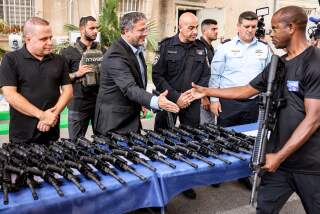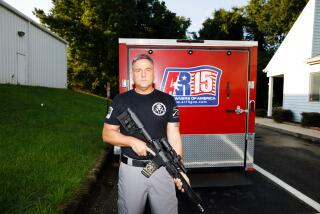With Disarming Smile, Inventor of AK-47 Recalls How He Shot to Fame : Weapons: Mikhail T. Kalashnikov, the Russian who made the gun that armed the world, now designs hunting rifles. Finally, with political liberalization in the former Soviet Union, he is free to travel.
- Share via
“Does it trouble you, Mikhail Timofeyevich, that your creation has killed so many people around the world?”
The kind-eyed old gentleman had heard the question before. Clearly, he has even put it to himself at times, in those long winters hidden away in the Russian heartland.
“All I can say,” he replied, “is that terrorists would have found something else to kill people with, even if there weren’t my Kalashnikovs.”
Forget Clinton. Forget Yeltsin. Forget Marx and Mohammed. For the gun boys of Somalia and the old boys of Vietnam, for the gangs of Los Angeles and the grunts of Bosnia, the name that matters is the name whose parts-- kah-LASH-nik-OFF--s nap and click into place like a fresh magazine of high-velocity ammunition.
Mikhail T. Kalashnikov, still cherub-cheeked if silver-haired at 74, was almost a boy himself, age 23, when he began designing the assault rifle they eventually dubbed the AK-47--”Avtomat Kalashnikova 1947.”
If, as Mao said, power grows from the barrel of a gun, this was the gun.
In 40 years as the standard issue for Soviet-bloc forces, as the weapon of choice for guerrillas from ‘Nam to Nicaragua, as the everyday tool of terrorists, perhaps 50 million copies of the “AK,” its descendants and clones have been produced in almost a dozen countries.
Rugged, dependable, cheap and 600-rounds-a-minute lethal, the no-frills Kalashnikov is history’s most widely distributed piece of killing machinery, the curve of its “banana” clip familiar to generations of TV news viewers.
And over the years it has done great damage, a toll that weighs on its creator.
This Siberian peasant’s son has told friends, for instance, that he sometimes wishes he had become an agricultural engineer instead of a weapon designer. Last year, he said publicly he wanted to establish a “fund for gunshot victims.”
When asked about the fund in an interview, he was interrupted by Elena, his daughter and traveling companion. That impractical idea was “a mistake,” she said.
Kalashnikov, offering no further explanation, moved on to another concern, his longtime hometown, Izhevsk, a city of a half-million people in the highlands west of the Ural Mountains.
Izhevsk was a major Soviet arms-manufacturing center, a “closed city” where Kalashnikov’s design team worked over the years to improve the AK-47 for the giant Izhmash defense enterprise. Now, he said, “these are very bad times.”
“In our region, everyone was in the military business. Now that there’s not such a demand, people are losing their jobs at Izhmash. It’s a mess.”
Kalashnikov feels the pinch himself, not having been showered with royalties like U.S. gun designers. “But the government was never against giving me medals,” he joked.
The hard-pressed local arms plants have hit on a Western-style marketing inspiration, capitalizing on the great designer’s name by forming something called “The Kalashnikov Joint Stock Co.” The shareholders are all old state enterprises.
In a telephone interview from Izhevsk, an Izhmash deputy director, Alexander G. Likhachev, explained that the new company is gearing up for an export push. He threw in a pitch for Kalashnikov rifles:
“They’re highly reliable and have a long service life. . . . They are better than, say, similar American products.”
But Kalashnikov himself seems out of the corporate loop. He thought his namesake company had never gotten off the ground. Then again, he acknowledged with a laugh, he has no head for business. “I’m just a designer.”
It’s evidence of the confusion that reigns as Russians try to reorganize their post-Soviet economy.
The looser times at least have set the old designer loose to see the world, including America, where he was interviewed while attending a recent gun show in Dallas.
“They really kept him prisoner all those years,” said American friend and host Berge Boghossian, an arms dealer who calls Kalashnikov “the sweetest man on earth.”
Emerging from his shell means facing questions, however, about sharing responsibility for a violent world. And that means retelling the story of the AK-47’s origins:
In 1941, tank commander Kalashnikov was wounded in a battle with Russia’s German invaders. In the hospital, other wounded men complained of their army’s deficit in infantry weapons--ancient bolt-action rifles versus the Germans’ modern firearms. Sgt. Kalashnikov, a clever mechanic, decided to spend his recuperation building a machine pistol like the Germans’.
His pistol was never put into service, but it established him as a weapons maker. In 1943 he competed with other designers on Russia’s first assault rifle--a weapon firing light rounds at a rapid rate, and also capable of single-round semiautomatic fire. When they dragged the Kalashnikov weapon through swamp water and it still fired, he was on his way.
The moral of the AK-47 story: “I built it to protect my country.”
Today, Kalashnikov still designs weapons, but only hunting rifles.
“I’m not going to work on any more military things,” he said.
Has he sworn off man-killing devices?
The cheerful old father of famous guns hesitated and smiled. “No,” he said. “It’s just that, into the next century, nothing is going to be made better than my rifle anyway.”
More to Read
Sign up for Essential California
The most important California stories and recommendations in your inbox every morning.
You may occasionally receive promotional content from the Los Angeles Times.













